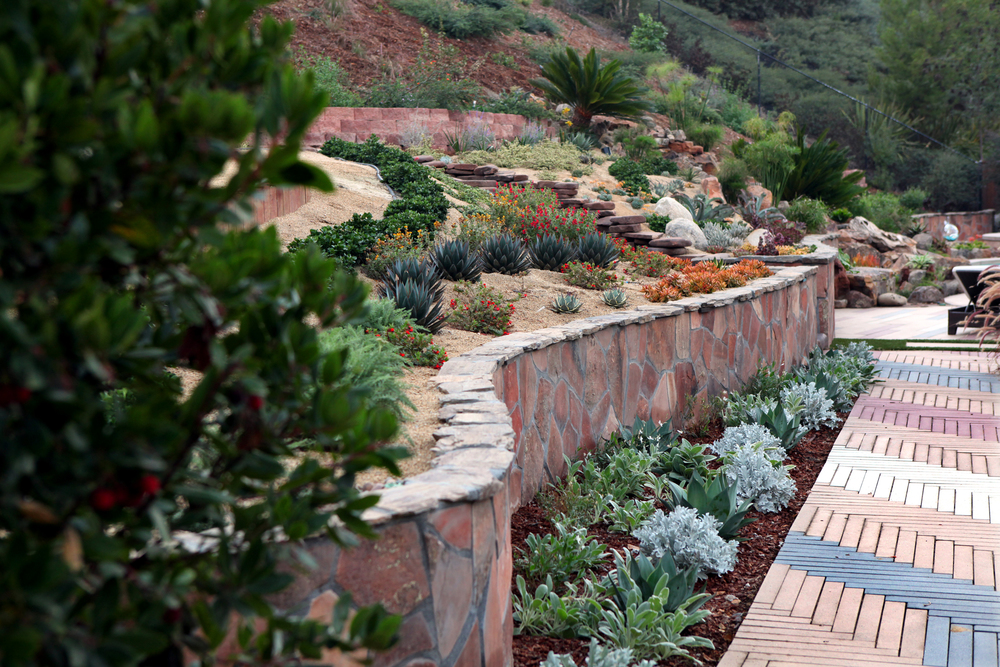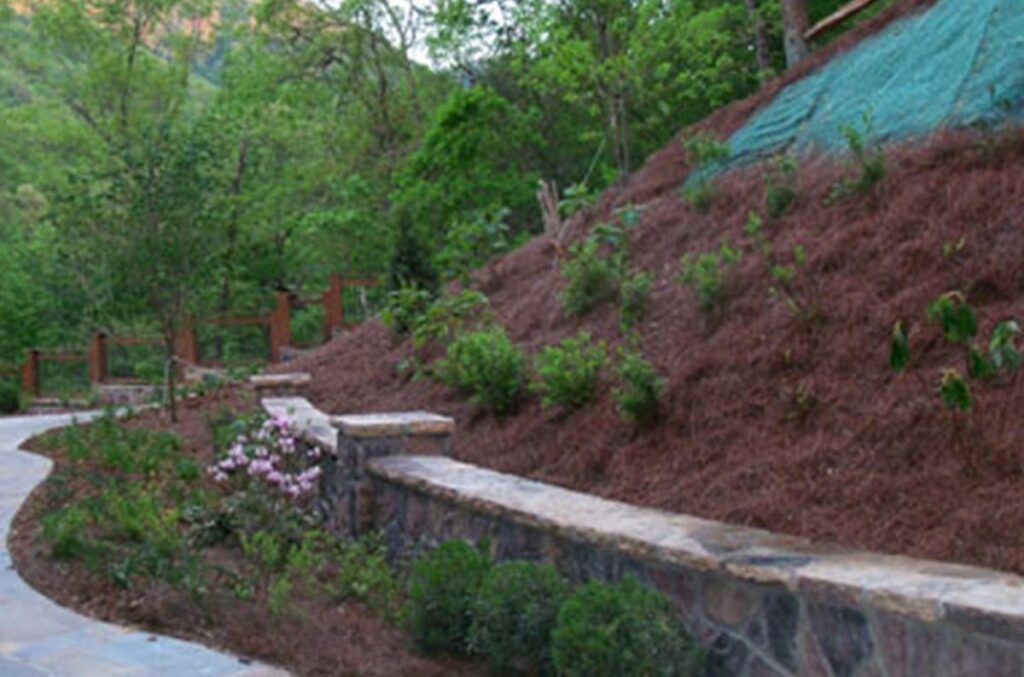Hillside Erosion Control
Free Hillside Erosion Control Estimates in Los Angeles and Ventura County
Welcome to Sequoia Builders, a premier contractor in hillside erosion control in Los Angeles and Ventura County area. We offer our clients a top service in hillside erosion control, helping their backyards with the best solution possible.
We offer all types of backyard hillside erosion control from artificial solutions, natural solutions, terraces, and more. Let our experts give you a free estimate on what we think the best possible solution is for your backyard. Call us today for your free no obligation quote.
Serving Los Angeles & Ventura Counties
- Treating slopes is essential to prevent erosion due to rainwater falling on bare soil.
- Erosion can result in buildup of silt and cause community issues, such as clogging storm drains.
- Every slope type presents a different challenge and requires specific techniques for erosion control.
- Plants are natural protectors of soil; their coverage reduces energy of raindrops and their roots bind the soil together.
- Hydroseeding is often used for immediate coverage until other plants mature.
- The angle of repose, geotextiles, soil type, and other factors affect plant success and erosion control efficiency.


The Role of Plants in Slope Treating and Erosion Control
Introduction
Slope treating is an important part of erosion control, and it involves the use of various techniques to protect land from erosion. Slope treating is especially important for vulnerable communities, as it can reduce the destructive effects of landslides, mudslides, and other natural disasters. Plants are known to play a crucial role in soil protection when it comes to slope treatments. Here’s what you need to know about how plants help prevent erosion on slopes.
How Plants Reduce Raindrop Energy
One way that plants can minimize soil erosion on slopes is by reducing raindrop energy. When raindrops hit the ground, they create shockwaves that can cause soil particles to become airborne and eventually be washed away. However, when these raindrops hit plants instead of bare ground, their energy is reduced significantly. This means that fewer soil particles will become airborne and less erosion will occur over time.
Benefits for Binding Soil Togetherof Plant Roots
In addition to reducing raindrop energy, plants also serve an important purpose when it comes to binding soil together. Plant roots penetrate deep into the ground and act like glue to hold soil particles in place. This helps to keep slopes stable even during heavy rains or floods, which can be especially beneficial for communities located near rivers or streams. Hydroseeding as an Immediate Solution for New Slopes
Hydroseeding is a method used for quickly establishing vegetation on newly created slopes. It involves mixing water with a slurry containing grass seed, fertilizer, mulch, and other materials that help promote plant growth. Hydroseeding creates an immediate solution for protecting new slopes from the dangers of erosion until more permanent solutions can be implemented.
Factors Affecting Plant Growth and Erosion Control Efficiency
The effectiveness of plants as a slope treatment depends on several factors such as angle of repose (the angle at which a material begins to slide), geotextiles (synthetic fabrics used to protect soil surfaces against erosion), and soil type (clayey soils are better suited for vegetation than sandy soils). It’s important to take all these factors into consideration before implementing any type of slope treatment involving vegetation.
Conclusion
Plants play an essential role in slope treating and erosion control by reducing raindrop energy and binding soil particles together with their roots. Hydroseeding is one way these goals can be achieved quickly with minimal disruption while other more permanent solutions are being implemented. While there are several factors that affect plant growth efficiency on slopes such as angle of repose, geotextiles, and soil type—all should be taken into consideration when planning any type of slope treatment involving vegetation if you want maximum results for your efforts! If you’re looking for ways to get involved with local projects or initiatives related to this topic area then get in touch with your local government or conservation groups today!
Erosion due to rainwater is a serious problem that needs attention, and treating slopes is the most effective way of handling it. Rainwater can tear away at bare soil damaging its structure, which in turn impacts how well plants can grow and how habitats for animals form. This can also lead to issues like flooding downstream as the water flows faster along channels eroded away by the rain runoff. Fortunately, treating slopes creates an effective barrier against this kind of erosion. Covering soil with vegetation like grasses or mulching helps slow down the water’s flow over the surface while also protecting whatever underground environment exists. This can go a long way in stopping any further damage that could have been caused by rainfall on exposed soil. Taking steps to treat slopes with appropriate methods is essential for preventing erosion and its associated problems.
Erosion is a serious issue that can have far-reaching implications in any given community. When erosion occurs, silt and other particulates are lifted up from the earth and moved with the wind or water, eventually settling in new areas. In many cases this buildup of residual particles can cause storm drains to become clogged, resulting in flooding during heavy rains and a disruption of services for those living nearby. This is why it is so important for communities to take proactive measures to prevent erosion from taking place before major damage can occur. Thankfully, today there are many proven methods which landowners can use to limit the effects of natural erosion.
Different slope types can have vastly different levels of difficulty when it comes to erosion control. Whereas a gentle grade may require little more than superior surface preparation, a steep slope may put significant stress on even the most experienced soil conservation specialist. Although basic principles like surface drainage and vegetative stabilization remain key components of any erosion control strategy, specialists must adjust their strategies for particular terrain characteristics, such as an open or shaded area, soil quality, or the presence of water bodies at the bottom. Even two slopes with similar inclines may pose distinct challenges that require a specialized and tailored reply from the professional overseeing erosion control duties. As always, the devil is in the details, and successful erosion control requires analyzing each job through multiple lenses before designing a plan for implementation.
Plants provide much more than just a normal track of greenery in our lives. In fact, plant life is essential to the proper maintenance of soil and the surrounding ecosystem. As natural protectors, plants reduce the energy of raindrops by blocking their course. Additionally, the roots and stems of plants bind the soil components together which helps to prevent erosion from occurring throughout the environment. Ultimately,a world without vegetation would not be a productive one; that is why it is so important for us to consciously strive for increased conservation and general care when it comes to caring for our planet’s vegetation.
Hydroseeding is an easy and economical method for creating a lush lawn or planting green spaces without the costly labor of laying sod or spreading seed by hand. This process shoots a slurry of grass seed and fertilizer suspended in water and mulch onto a lawn. This can be used for both new turf and repairs, resulting in fast-growing results that look much better than traditional methods providing immediate coverage before other plants have time to mature. It is an efficient way to generate green spaces due to its ease of use and low maintenance while still getting an impressive result.
Plant success and erosion control efficiency is heavily dependent on a variety of factors, such as the angle of repose. Normally, anything steeper than 45 degrees can be problematic for establishing vegetation, due to the potential for soil slippage. Geotextiles are a necessary means of ensuring soil persists on the slope until plant roots become established and help anchor it into place. Different types of soil require different methods when controlling erosion; coarser soils with larger aggregate particles can resist more water movement while clay-rich soils allow water to pass through easier. All these factors contribute to how successful plants can be in controlling soil erosion. Combined with well designed drainage systems, these techniques make a big difference in how resilient a slope becomes over time.
Get into the world of Sequoia Builders!
Lean your conscious towards sooting your soul surrounded by masonry, pool, and patio.
